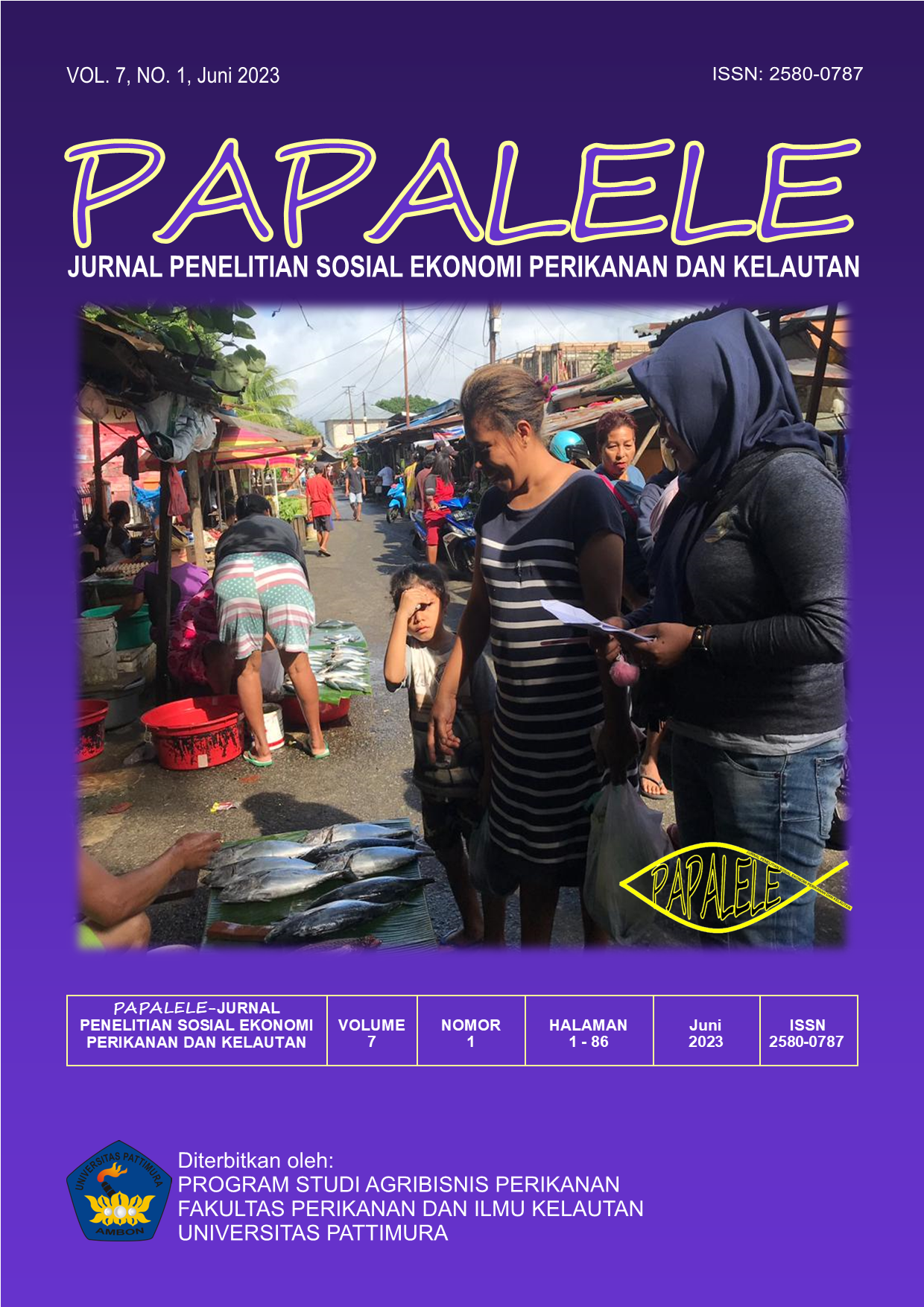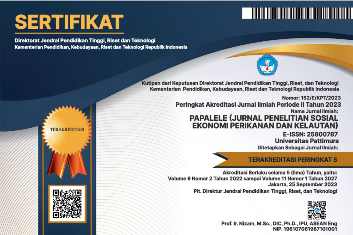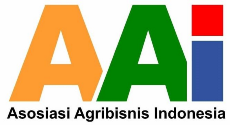SEME (SOCIAL AND ECOLOGYCAL MARKET ECONOMY) TERHADAP KEBERLANJUTAN SUMBERDAYA PERIKANAN DAN KESEJAHTERAAN NELAYAN
Abstract
Fisheries resources are very vulnerable. Integrated management is needed between regions, sectors and stakeholders to sustain fisheries resources. Good management will provide the maximum benefits of the environment, economy and society. "Social and Ecological Market Economy" (SEME) is based on determining a triangle strategic, is the combination of capital, labor and environmental sustainability. This concept is needed as a benchmark in maintaining a balance between resource sustainability, fishermen as beneficiaries and the economic side to ensure the sustainability of fishermen's lives and prevent poverty. Some of the instruments that can be implemented based on the SEME concept are: 1) Supporting laws and regulations, 2) Improving the local market economy, 3) Creating a network of cooperation, and 4) Forming fishing activities and businesses based on environmental sustainability.
Downloads
References
Basurto, X., Coleman E. (2010). Institutional and Ecological Interplay for Successful Self-Governance of Community-Based fisheries. Ecol Econ 69: 1094–103.
Benecke, D.W. (2008). Social and Ecological Market Economy. A General Overview. Ed. By Deutsche Gesellschaft fürTechnische Zusammenarbeit (GTZ) GmbH, Eschborn, p.23 - 52.
Bennett, N. J., (2016). Use of perceptions to improve conservation and environmental management. Conserv. Biol. 1, 1–5.
Cinner, J. E., Pollanc, R. B. (2004). Poverty, Perceptions and Planning: Why Socioeconomics Matter in The Management of Mexican Reefs. Journal Ocean & Coastal Management 47: 479–493.
Eagles, P. F. J., Romagosa, F., Buteau-Duitschaever, W. C., Havitz, M., Glover, T. D., McCutcheon, B., (2013). Good governance in protected areas: an evaluation of stakeholder’s perceptions in British Columbia and Ontario Provincial Parks. J. Sustain. Tour. 21, 60–79.
Erwina, Y., Kurnia, R., Yonvitner. (2015). Status Keberlanjutan Sumberdaya Perikanan di Perairan Bengkulu. Jurnal Sosek KP, 10 (1) : 21-34
Federal Ministry for Economic Cooperation and Development. (2007). Social and Ecological Market Economy Principles in German Development Policy. Federal Ministry for Economic Cooperation and Development, Bonn – Germany.
Gauger, L.O., Richmond, L., Hackett, S., Chen, C. (2018). It's a trust thing: Assessing fishermen's perceptions of the California North Coast marine protected area network. Ocean & Coastal Management, 158: 144-153.
Hoedl, E. (2014). European Transition into a Socio-ecological Market Economy. Cadmus, 2 (3): 84-93.
Horngren, C. T., Datar, S. M., Foster, G. (2008). Akuntansi Biaya: Penekanan Manajerial. Buku Kedua, Edisi Kesebelas. (Diterjemahkan oleh: Desi Adhariani). Indeks. Jakarta.
Hughes, T. P., Bellwood, D. R., Folke C., Steneck, R.S., Wilson J. (2005). New Paradigms for Supporting the Resilience of Marine Ecosystems. Trends Ecol Evol, 20(7): 380-386. DOI: 10.1016/j.tree.2005.03.022.
Hatcher, A. A., Jaffry, S., Thébaud, O., Bennett, E. (2000). Normative and Social Influences Affecting Compliance with Fshery Regulations. Land Econ 76: 448–61.
Hauck M, Kroese M. (2006). Fisheries Compliance in South Africa: A Decade of Challenges and Reform 1994–2004. Mar Policy 30: 74–83.
Humaedi, M.A. 2012. Kemiskinan Nelayan: Studi Kasus Penyebab Eksternal dan Upaya Revitalisasi Tradisi Pengentasannya di Kaliori, Rembang, Jawa Tengah, Jurnal Sosek Kelautan Perikanan, 7 (2) 193-206.
Imron, M. (2003). Kemiskinan dalam Masyarakat Nelayan. Jurnal Masyarakat dan Budaya, 5 (1): 63-81.
Juliantono, F. J., Munandar, A. (2016). Fenomena Kemiskinan Nelayan: Perspektif Teori Strukturasi. Jurnal Kajian Politik dan Masalah Pembangunan, 12 (2): 1857-1866.
Kirlin, J., Caldwell, M., Gleason, M., Weber, M., Ugoretz, J., Fox, E., Miller Henson, M., (2013). California's Marine Life Protection Act Initiative: supporting implementation of legislation establishing a statewide network of marine protected areas. Ocean Coast. Manag. 74, 3–13.
Kusnadi. (2002). Konflik Sosial Nelayan: Kemiskinan dan Perebutan Sumberdaya Perikanan. Yogyakarta, LKiS.
Lambert, V.A., Clinton, L. (2012). Qualitative Descriptive Research: An Acceptable Design. Pacific Rim International Journal of Nursing Research. 16 (4): 255-256.
Leleu, K., Alban, F., Pelletier, D., Charbonnel, E., Letourneur, Y., Boudouresque, C.F., (2012). Fishers' perceptions as indicators of the performance of Marine Protected Areas (MPAs). Mar. Policy. 36, 414–422.
Meisthya, P. I. A., Sudriman, I. W. (2014). Variabel Yang Berpengaruh Terhadap Penyaluran Kredit Modal Kerja Usaha Mikro Kecil Menengah UMKM di Bali Periode 2001. Jurnal Ekonomi Kuantitatif Terapan, 3(3): 96-105.
Putra, P. M. S., Kartika, N. (2019). Analisis Pengaruh Modal, Umur, Jam Kerja, Pengalaman Kerja, dan Pendidikan Terhadap Pendapatan Nelayan di Kedonganan. E-Jurnal Ekonomi Pembangunan Universitas Udayana, 8 (2) : 272-303.
Riegler, J. (2003). Eco-Social Market Economy as an European Innovation. Agric Econ- Czech, 49(3): 101-105.
Silva, M. R. O., Lopes, P. F. M. (2015). Each Fsherman is Different: Taking the Environmental Perception of Small-Scale Fshermen Into Account to Manage Marine Protected Areas. Marine Policy, 51: 347-355.
Webb, E. L., Mailiao, R., Siar, S. V., (2004). Using Local User Perceptions to Evaluate Outcomes of Protected Area Management in the Sagay Marine Reserve, Philippines. Environ. Conserv. 31,138–148.
Wilkinson, C., Souter, D. (2008). Status of Caribbean Coral Reefs After Bleaching and Hurricanes in 2005. Global Coral Reef Monitoring Network, and Reef and Rainforest Research Centre, Townsville, 152 p.
Yanutya, P. A. T. (2013). Analisis Pendapatan Petani Tebu Di Kecamatan Jepon Kabupaten Blora. Economics Development Analysis Journal, 2(4): 286-296.
Copyright (c) 2023 Ivonne Raystika Gretha Kaya, Sajriawati Sajriawati

This work is licensed under a Creative Commons Attribution-NonCommercial 4.0 International License.











